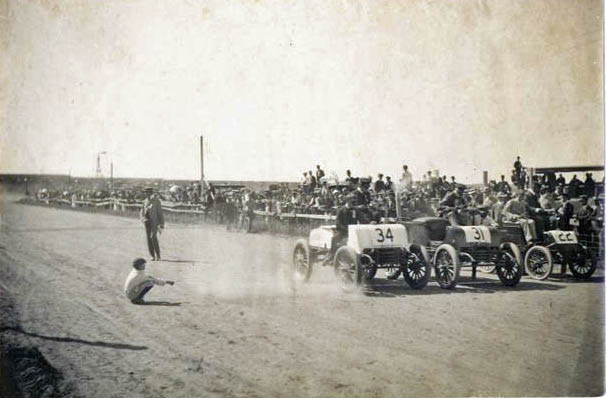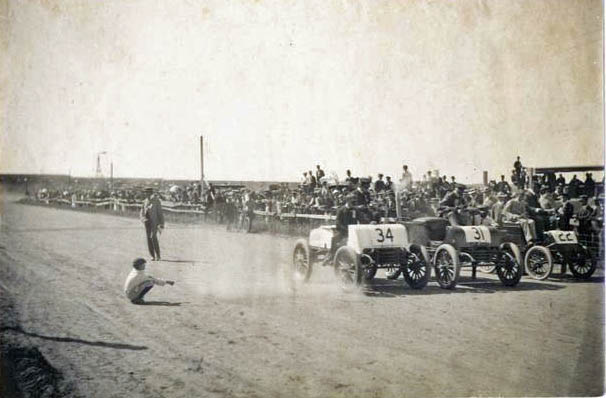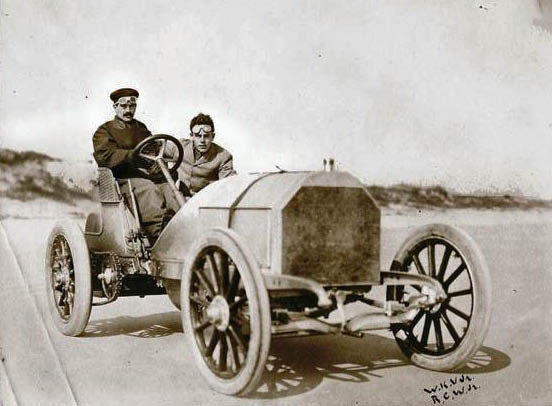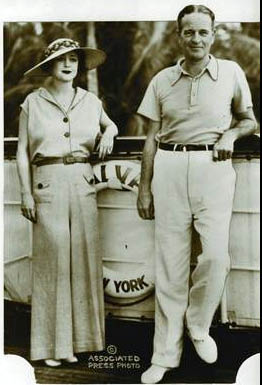Providence Journal: “Vanderbilt and friends competed on Middletown track at the dawn of auto racing”

George Kennedy has written this article on William K. Vanderbilt Jr. in the Providence Journal.
Check out who is the "authority on the subject".
Enjoy,
Howard Kroplick
R.I. Car History: Vanderbilt and friends competed on Middletown track at the dawn of auto racing
February 15, 2014
By George Kennedy
Special to The Journal
A car race around Newport’s Ocean Drive. It sounds as absurd now as when Willie K. Vanderbilt Jr. suggested it in 1900. But the young heir to one of the greatest fortunes in American history had a love for the automobile and he wanted to share that passion with his contemporaries.
That dream came into fruition as what many consider the first sanctioned, oval-track race held in our nation’s history. After 1901, races were held on the beaches of Newport, albeit with less formality.
William Kissam Vanderbilt II was one of the first motorists in the country. At age 10 “Willie K.” rode a three-wheeled steam-powered tricycle on the French Riviera, and from there he was hooked. His love for the automobile would eventually result in the formation of the Vanderbilt Cup, an automotive competition that predated the Daytona race by decades, and it all started on a horse track in Middletown.
“Willie K. originally wanted this race on Ocean Drive,” explained Matt Plumb, a professional race car driver in the Continental SportsCar Challenge. “But the residents of Newport would never allow it.”
Plumb participates in the pinnacle of motor sports at the wheel of a heavily modified Porsche 911. His profession owes its deepest roots to Willie K. and his desire to bring a race to Newport — whatever the cost.
“There was a horse track in Middletown,” said Plumb. “It became the home of the race, but it turned into more of a festival of speed.”
With the plans of an Ocean Drive sprint dashed, the equestrian oval became the home of the first ever automobile race in 1900, and Willie K. came well-equipped.
“In June of 1900, Willie K. bought a Daimler Phoenix,” described Howard Kroplick, an authority on the subject.
“He bought it for $10,000, which would translate to about $250,000 in current dollars.”
Kroplick is the town historian for North Hempstead, N.Y., and is the author of two books on the life and automotive exploits of Willie K. Vanderbilt Jr. According to Kroplick, Vanderbilt took great pride in the 23-horsepower Daimler, naming it the “White Ghost.”
On September 6, 1900, the Ghost would meet the preferred chariots of Vanderbilt's contemporaries. “Fellow Newport millionaires participated in the races,” explained Kroplick, “including John Jacob Astor and others.”
At the Aquidneck Horse Park, which is now home to Newport State Airport, Rhode Island’s motoring elite held five races. By sundown on that late summer day, Willie K. had won the races — averaging then-unheard speed of 33.7 mph. This motoring exhibition apparently instilled the same passion for motorized conveyance that struck him on a steam-powered trike years before.
Another race was planned for the following year.
The notion of 30-horsepower mechanical wagons may not seem appealing now, but you have to understand the state of the art.
In 1900, the automobile was the iPhone. The Wright Brothers’ creation would not fly for another two years — the automobile was the height of technology and design, and it drew crowds in their best garb.
“What’s fascinating is that people came to races in formal dress, as if they were going to a ball,” explained Kroplick, “They treated this like a high-society event, and it made sense, since it brought them in to the presence of Newport’s elite families.”
Vanderbilt and others apparently presumed that this popularity would translate in momentum for a more daunting event, and continued to pursue the idea of a race on the main streets of Newport. The powers-that-be would not have it, and in 1901, Willie K. and others took to the same horse track, albeit in far more advanced machinery.
Yet, the anti-auto sentiment persisted among those who would hold the keys to Vanderbilt’s Newport racing hopes. A final attempt at racing down Ocean Drive resulted in an injunction, and Willie K. had enough. He took his passion abroad.
“Following the 1901 race, he received bad publicity.” explained Kroplick, “he went to Europe to take part in the famous city-to-city races.” Instead of an outlier, he entered the European motoring fray, competing with as many as 500 cars in events like the notable Paris-to-Madrid race. There his resolve for racing returned, and he brought it back to the States in the form of the Vanderbilt Cup, the first major trophy in automobile racing.
Though the Cup would take place on his new home of Long Island, Vanderbilt’s biggest claim to fame would come on the beaches of Florida. “On Jan. 27, 1904, Willie K. set the one-mile land-speed record at Daytona,” explained Kroplick, “He hit 92.3 mph in his powerful Mercedes.”
It was an incredible feat and an expressive jump in performance since just years before.
Yet the march forward in automotive prowess is not always found in leaps, but sometimes in nuance.
Plumb and others would like to bring a vintage race to Newport one day, and the spirit of Plumb’s modern race circuit echoes the lust for advancement once embodied by Willie K.
Because no matter the state of the engineering, a true racer will always want to find a way to go faster. They will continue to push the envelope, not just for themselves in that race, but for the legacy they leave — and the hopes that they were fast enough that someday someone will write about them, too.
George Kennedy is a Massachusetts- based freelance auto writer with Rhode Island roots. He can be reached at [email protected]. Follow him on twitter @GKenns101.

A young boy is seen crouching on a track on Aquidneck Island as spectators line the fence for a race in 1901 among mostly unknown drivers. Photo courtesy of the Newport Historical Society.

William K. Vanderbilt Jr. and his mechanician in his 90-horsepower Mercedes at the Ormond Beach races in 1904. Vanderbilt set a new land speed record of 92.3 mph that year. Photo courtesy of the Suffolk County Vanderbilt Museum.

Rosamund and William K. Vanderbilt II on their yacht, Alva , in 1935.

Comments
From Ariejan Bos
The Aquidneck photo is very nice and unknown to me. The drivers and cars may be unknown now, but still have names. The race in Aquidneck Trotter Park on August 30, 1901 is fairly well documented, so this photo is easy to caption. What we see is the start of the first of 5 heats of the race for gasoline vehicles developing not more than 12 hp. The competitors are F. Walsh on Gasmobile #34, F.H. Benedict on Gasmobile #31 and H.L. Willoughby on Autocar #22. The final of the race was eventually won by A. Fischer on Gasmobile.
Hello to all. Family and I just literally returned from our timeshare vacation. In. Newport , RI. Even though my boys had no interest in touring the Newport Mansions, we did it anyway. We toured The Breakers, Marble House (both Vanderbilt summer homes), and The Elms (summer home of coal magnate Edward Berwind). They didn’t allow interior photography.I’m glad we did it. I’m particularly impressed with Mr. Berwinds life story.